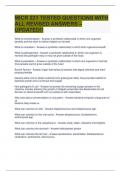Exam (elaborations)
MICR 221 TESTED QUESTIONS WITH ALL REVISED ANSWERS – UPDATED!!
- Course
- Institution
MICR 221 TESTED QUESTIONS WITH ALL REVISED ANSWERS – UPDATED!! What is commensalism - Answer-a symbiotic relationship in which one organism benefits and the other is neither helped nor harmed What is mutualism - Answer-a symbiotic relationship in which both organisms benefit What is pathog...
[Show more]



